Each owner wants to protect his house or summer cottage from penetration ...
|
|
The stretch ceiling is the ideal option for finishing the ceiling for lazy and practical ... |
Sooner or later, each of us is faced with the need to build or repair ... |
A warming cable for the water supply with your own hands. We prepare the system for cold winter
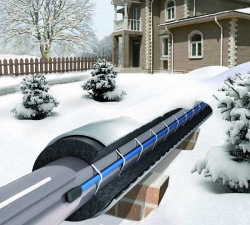
To prevent the route of the water supply system in severe frosts, it should be considered that it will help to avoid an unpleasant situation, the cause of which at best becomes interruption with water supply, in the worst solution of the system and breaking pipes. Experts recommend using the so -called heating cable. The installation of such a system will prevent freezing of water in the pipes, help maintain the pressure at the proper level, and when installed in the new system, it will allow the water supply at a lower depth. Consider what a warming cable is and how to make it yourself.
Table of contents:
- Why do you need a warming cable
- Varieties of heating cable
- Resistant heating wire
- Self -regulatory heating cable
- The advantages of self -regulating cables over resistive
- Installation of self -regulatory heating cable internal work
- Hearing the external installation cable with your own hands
- Connecting a heating cable
- How to make a heating cable with your own hands
Why do you need a warming cable
Since we live in regions with unstable winters, sharp temperature changes, we must think about additional protection of sewer and water systems. The route of these vital points will make the inhabitants of the house carry out partial repairs or restore the entire system. To prevent trouble, they should be prevented. And this can be done when using a heating cable that will not allow water will freeze. The meaning of the work is based on the release of heat into the water supply system and, as a result, preventing the size of the pipes. Two cable options are used:
- self -regulatory;
- resistant.
Below we consider each of the options in more detail. In principle, the mechanism of their action is similar, heat is released due to the electric current and the threat of freezing of the water supply system is prevented.
The question of why it is necessary to use cable heater is a definite answer to prevent damage to the water supply, sewage system and the like.
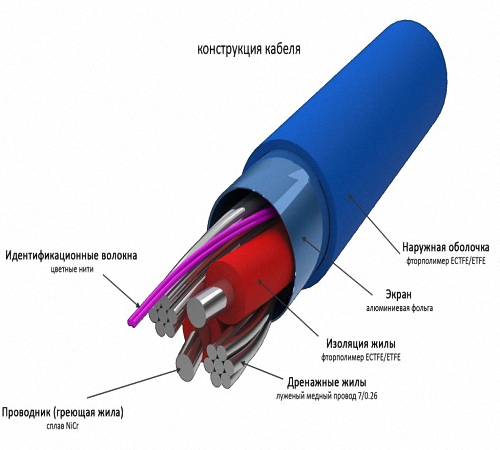
Varieties of heating cable
Two varieties of heating cable are known:
- resistive;
- self -regulatory.
In the first type of cable, a feature of the metal is used to warm up from the passage of current. When heated, the conductor emits a fixed amount of heat, which does not depend on the ambient temperature. That is, this option of a cable always consumes the same amount of electric energy. To reduce costs at normal temperatures and the absence of frosts, special sensors and thermostats are mounted in the system. During the installation of a system using a resistive cable, a very important requirement that the cable threads do not lie down to each other and there is no overlap. With this location of the cable, overheating and damage to the wire occurs.
A resistive heating wire can consist of one or two cores. The two -core wire is more expensive, but it is used more often. They are easier to connect, since they have a plug from one edge, and one -cereal requires connection from two ends. Resistant wires are not allowed to cut, otherwise they will not work. This nuance should be remembered when laying this kind of wire if the bay has a large length than you need, you still have to lay it completely.
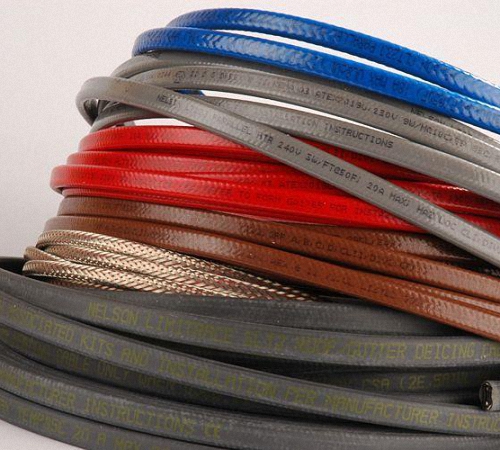
Self -regulating wires metal are polymer bases. The veins carry out current and this heats the polymer, this is the principle of operation of a self -regulating cable. The interesting feature of the polymer is that the stronger it warms up, the less heat releases and the more cools, the more heat gives. It independently regulates the temperature from here and the name. You can distinguish such positive aspects in a self -regulating cable:
- when in contact or intersection with each other, the material does not deteriorate and does not burn out;
- this type of wire can be cut, the ending should be closed;
- long operational term.
The downside is a rather big cost, but the costs will pay off high quality of the material.
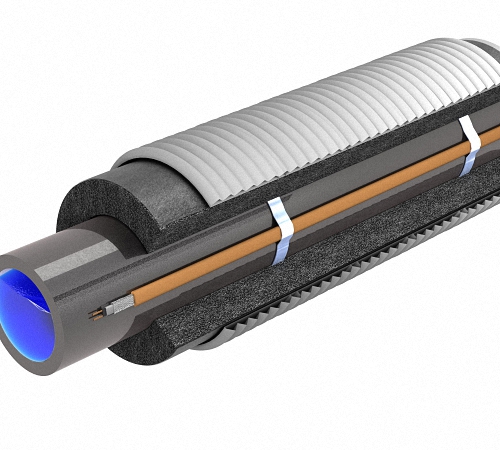
Resistant heating wire
A resistive heating cable has a clear principle of operation and can be presented like this: in the water supply pipes from the inside or outside the cable is laid, temperature sensors determine how low degrees of the environment are determined and when the heating system is automatically launched. The thermostat responds to any deviation from the specified parameters. The current begins to flow, the system and water are heated. When the indicated parameters are reached, the system is automatic.
The water heating cable is the metal fibers that are insulated. It is necessary to control the heating process, since heating occurs immediately along the entire length and the wire can easily burn. In order for the coefficient of the useful action of the heating cable to be effective, it is necessary to take care of thermal insulation, this will save on electricity and reduce heat loss. For insulation, mineral wool and any other material with low heat loss are suitable.
The cable is laid in a row or spirals, without tension. Fix to the surface of the pipe using a special adhesive tape. If desired, the pipe is wrapped with aluminum foil. This enhances the contact of the cable and pipes and improves heat dispersal over the surface. The cable of this type is used not only to prevent freezing of the water supply system, but also in other systems, for example, on the roof, against the formation of icicles.
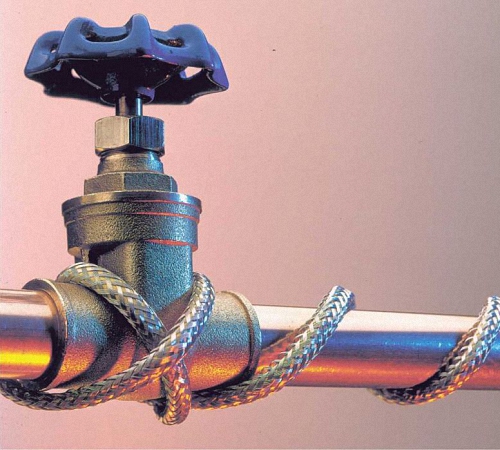
Self -regulatory heating cable
A self -regulating wire or cable is a heating conductor that changes the level of heat given depending on the ambient temperature. The colder around, the stronger the cable is heated and the heat is released into the tap system.
The wire of:
- two cores that provide voltage along the entire length of the wire;
- heating matrix and insulation layer;
- for reliable thermal protection, the veins are wrapped in several layers of insulating material;
- braid for grounding and protection against various kinds of influences;
- the outer shell protecting the wire from mechanical exposure.
All this together ensures the stability of the wire to damage and extends the service life.
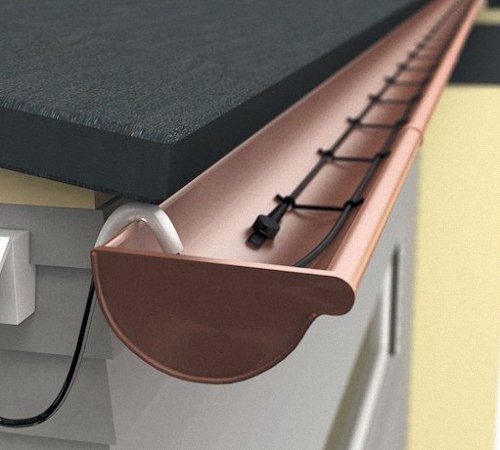
The advantages of self -regulating cables over resistive
Having analyzed the features of two options for cables, we can say that the self -regulating cable significantly wins before the resistive:
- a self -regulating cable can be cut along the required length;
- the contact of the foundations will not cause cable damage;
- the temperature is regulated, while the resistive cable has constant indicators;
- the cable is highly resistant to voltage drops;
- the wire is resistant to mechanical damage;
- durable and reliable.
If you choose between two options, the solution is obvious, even the fact that a self -regulating wire is more expensive, does not affect its popularity.
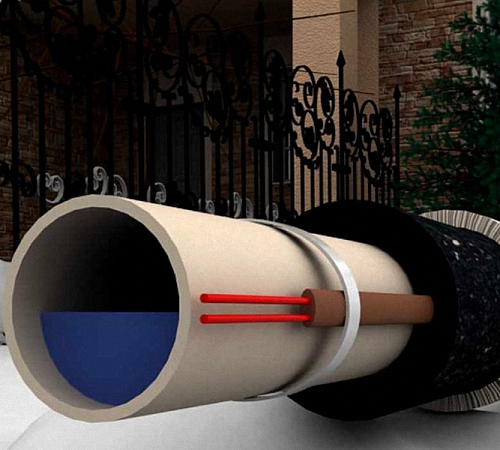
Installation of self -regulatory heating cable internal work
The heating cable is laid on the outer or inside of the pipe. In principle, a little different material is used for each option. Consider the option of mounting the wire from the inner surface. The material that will be installed inside the pipes must meet certain requirements:
- the external coating of the cable should not be the source of the allocation of negative and harmful substances;
- electrical protection must comply with the established standards;
- the end of the cable should be closed with a special coupling.
The wire is refuel into the pipe. The transition place between the two cables (heating and electric) is not in the pipes, since it is not intended for places with high humidity. The tee for mounting a heating cable from the inside happens with a variety of assignment angles, with an internal installation version is not fixed, but simply refuel inside.

Hearing the external installation cable with your own hands
If the installation of a warming cable is located on the outer side of the pipe, you need to monitor a dense fit along the entire surface. If not new pipes are installed, they are viewed about dust, pollution, rust, welding and, if necessary, cleaned of an outsider. All unnecessary parts can ruin the cable. The wire must be securely fixed every twenty -thirty centimeters, a special adhesive tape or plastic clamps will be the material for fixing.
If you plan to lay a heating cable from two parts, place them below, where the temperature will be minimal, if there are three threads, most lay down, and one at the top. Thus, water pipes will be protected as much as possible from low temperatures.
There is another option for laying a cable on the outside of the pipe. This is a way of laying the wire with a spiral. During the processing of pipes, do not forget that with bending, the cable may be damaged. It does not tolerate bends, for this, the tangle of the wires is unwinded gradually and immediately wrap the pipe or fixed by sagging and attached with a sticky with a construction tape. If the wire is attached not on a metal, but a plastic pipe, then before laying the wire, the surface of the water pipe is treated with a layer of metal tape. Around the components: tees, fittings, cranes, it is recommended to make loops from the wire, since it is these parts that require maximum protection. But you should ensure that the warming wire does not have sharp bends during insulation around the cranes and similar parts of the system.
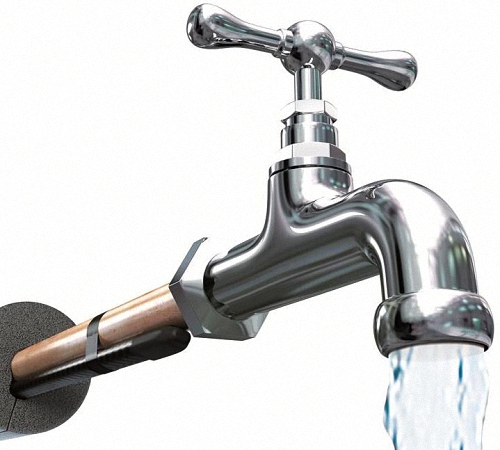
Connecting a heating cable
To connect the cable, you need to prepare the material and tools. For installation, you will need:
- heating wire;
- special boxes for connecting a cable;
- adhesive tape;
- aluminium foil;
- pliers.
There are three cable connecting options:
- linear (in a straight plane);
- spiral;
- interior.
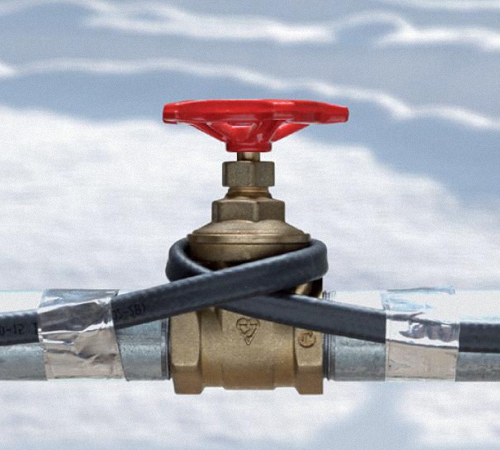
Linear version of laying the wire over the pipe. Most often, it is this method that is used during installation. With this method of laying, the likelihood of damage to the cable cores is excluded.
The spiral version is wrapping the wire onto the pipe in the form stuck. Sometimes a linear styling scheme is impossible, then it is replaced with a spiral one. Cable consumption in this case is greater.
Another option for laying the cable inside the pipe. This option is used when external installation is impossible. This option is not very good because the maintenance is difficult, reduces the life and reduces the throughput of the pipe.
How to make a heating cable with your own hands
A heating cable can be bought at any construction store, but the cost of products is quite high. In order not to spend a family budget, you can make a heating cable yourself using alternative material. Homemade experts found that the most suitable alternative to the purchased ghost cable will be a power telephone cable, which serves for field communications in the army. It can be used as a heating cable due to its characteristics: the cable is thin, hard, well -insulated, can be used in places of high humidity.
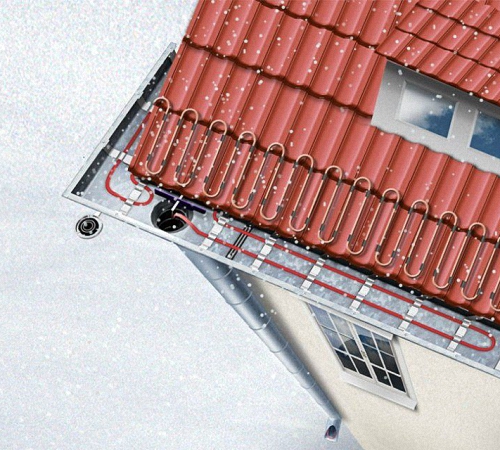
Two types of cables have only similar characteristics, but not identical. The field cable is devoid of such severe isolation as heating and it does not have a self -regulation function. But this is not a problem, if you apply a home -made version constantly, but only from case to case, to install not inside the pipe, but from the outside, in this case, the superpowers of the heating cable are not needed. Pouring water pipes, it is important to pay attention to the ends of the wire, carefully treat them with sealant or a similar substance. To attach wires to the surface of the pipes should be very tight, on the first layer of foil. It is recommended to be covered with tape, which will perform the function of thermal insulation material. You can also process sewer pipes.
As you can see, it is not difficult to lay a heating heating cable for a water supply cable for a water supply system and quite real for any home master. The main thing is to decide on the type of cable, a gasket option. If there are difficulties or not everything is clear from the installation of a heating cable, watch the video. There it is described in detail about the procedure for conducting actions and you will not have any questions.
